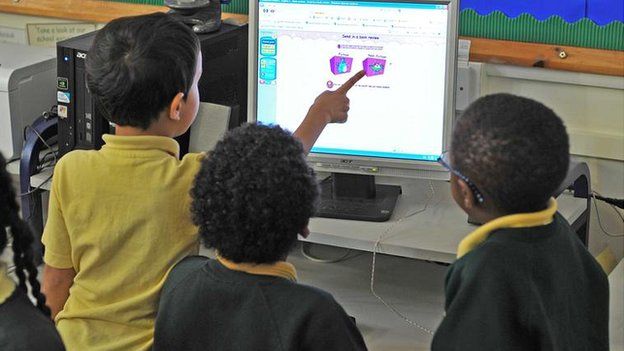Study reveals school segregation
- Published

A study of ethnic "segregation" in schools in England shows 61% of ethnic minority pupils enter schools where ethnic minority pupils are a majority.
Of pupils classified as "white British", 94% are in schools with a white British majority.
Researchers say schools are more segregated than their local areas.
"We would hope for a much greater level of integration for students," said Richard Norrie from the Demos think tank which published the report.
The analysis from the Demos Integration Hub and Simon Burgess of the University of Bristol looks at how white and ethnic minority pupils are spread within schools.
Most segregation
It shows patterns of pupils being more likely to be taught with pupils from a similar background - in a way that does not always reflect local populations.
In London, about 26% of pupils are white British, but 49% of these children are in schools with a white British majority.
Children from Bangladeshi, Pakistani and black Caribbean communities are also disproportionately likely to be at school with children from the same ethnic background.
About a third of pupils in primary school are now from ethnic minorities, but this study shows that below this average there are very wide regional differences.
In seven local authorities in London, there are no white British pupils in a school with a white British majority. While in 71 authorities across England, there are no ethnic minority pupils in schools where they are in a majority.
The study examines where there is greatest segregation, in terms of how dissimilar school intakes are to local populations.
The top 10 authorities with the highest levels of segregation are mostly in the North and Midlands: Blackburn with Darwen, Birmingham, Haringey, Bradford, Rochdale, Kirklees, Leicester, Oldham, Rotherham, and Manchester.
The study does not examine why or how such segregation takes place, on a local or national level, but it says that research shows that this is not simply a reflection of where people live.
It points to research that "schools were more segregated than the local neighbourhoods that they served".
'Unconscious choices'
Trevor Phillips, chairman of the Mapping Integration Project at Demos and former head of the Commission for Racial Equality, speaking on BBC Radio 4's Today programme, said this was "not a story of terrible racial hostility".
Instead, he said, it reflected demographic shifts and a pattern of the individual, localised choices of parents about where they and their children would feel "comfortable".
"Most families unconsciously make a choice which tends to line up with their own racial background," said Mr Phillips.
But he said this tendency towards separation had a negative effect, not preparing children for a diverse society.
Mr Phillips said the success of schools in London showed how much children from all backgrounds could benefit from schools with a high proportion of ethnic minority pupils.
Prof Burgess said that although schools "in some places remain highly segregated", the longer-term trend is that such separation is "generally declining or is stable".
But Dr Norrie said: "While we couldn't expect these communities to spread out on a truly equal scale, we would hope for a much greater level of integration for students at the start of their education."
The analysis of ethnicity and education shows that, allowing for socio-economic factors, white British pupils are the lowest achieving group at GCSE level.
The study also shows that ethnic minority pupils are more likely to have private tutors, more likely to attend private school and go to a Russell Group university than their white counterparts.
Last week, Ofsted chief Sir Michael Wilshaw said that there needed to be more good and outstanding schools available to white, working-class communities.
Sir Michael warned that white low-income families can feel "abandoned" and "forgotten" by the school system.
- Published1 July 2015